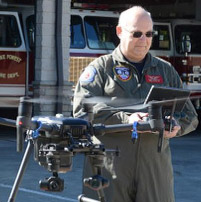The hardest decision you will have to make
Flying for public safety poses unique challenges that must be dealt with on nearly every flight. Under pressure, the most fundamental question in aviation—Is it safe to fly today?—can be difficult for any pilot to answer.
It is one thing to face deciding if it is safe to fly when you are not under any pressure. But if you are under pressure to save a life, find a suspect, or search for a missing person, then the pressure can tip you toward making the wrong choice.
This AOPA Air Safety Institute online video describes the problematic pressures and decision making in public safety flying from a manned aircraft perspective.
Aeronautical decision making is a fundamental part of training for most FAA pilot certificates. This “book knowledge” helps to ingrain in us the concepts, thought process, and tools to make sound and defensible decisions about managing risks. The wrong decision can lead to disaster; depending on the outcome, one or more of your pilot certificates might also be at risk.
What I’m up against
A couple of months ago, I was dispatched in the middle of the night to search for a missing child with autism. I established a safe and open landing zone and began the search flying a DJI Matrice 210 with a thermal camera.
With approximately 55 percent battery power, the drone initiated an autoland, and I was unable to keep it in the air. The system provided a warning that it was landing in 10 seconds. It was coming down over a row of townhomes. During the flight, the gimbal on the thermal camera had frozen at about a 45-degree downward angle.
With only lateral control, I managed to steer clear of the rooftops and land the drone in the middle of a parking lot. The barely controlled descent path narrowly avoided striking nearby vehicles and police officers. People at the scene asked me how I was able to do that. The honest answer is 10 percent skill and 90 percent luck.
DJI has examined my flight data files and replied to some emails, but after two months of back-and-forth, I still don't know the exact cause of the unexpected autoland.
Others who have seen the flight data logs point to potential issues with batteries or cells. But nobody can say with any real confidence what caused the problem. At best, it's a guess. Spending thousands of dollars to replace the batteries might not help.
Pilots certificated by the FAA are required to determine if their aircraft is safe to fly before flying it. That means we all share a burden of responsibility.
Even if the pilot in question does not have an FAA certificate, such as a pilot flying under a certificate of authorization (COA) granted to a public entity, such public aircraft operations make the department, county, or state ultimately responsible for liability, and for determining if the aircraft is safe. For flights not authorized as public aircraft operations, the pilot must abide by Part 107 regulations.
But how do we do that?
Unmanned aircraft available today have not been subject to the same kind of testing that certified aircraft must go through, and reliability data is hard to come by.
Seeking knowledge
Here is the tough decision I'm faced with that seems to be unsolvable unless I just ignore it: Is it "safe" to fly a UAS in demanding situations with a history of forced landing that can't be diagnosed? Or is the aircraft unsafe until the cause can be identified? Does assuming it won’t happen again make any sense?
I did eventually send the Matrice 210 that I flew back to DJI, and I asked the company to inspect the aircraft and issue the department a letter after repair that the drone was safe to fly. I was told they could not or would not do that. We turned the aircraft around in transit and had it sent back. Why pay for services that can't determine the aircraft is ready for safe operation?
I have begun gathering data from fellow remote pilots about flight failures and other UAS issues they have experienced and working to make information available to all UAS pilots. I created a website to collect and distribute as much of this information as possible, and hope to help everyone make more informed decisions.




